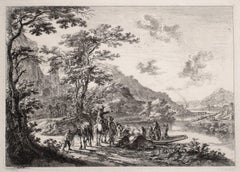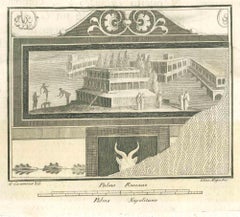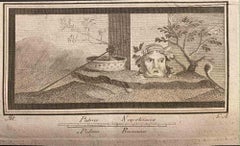Jan Dirksz Both Landscape Prints
to
1
Overall Width
to
Overall Height
to
1
1
169
158
146
131
1
1
1
1
1
Artist: Jan Dirksz Both
View of the Tiber with Country Landscape
By Jan Dirksz Both
Located in Chicago, IL
Etching on paper with Schriftband watermark.
Reference: Bartsch 7 III/IV (from VI).
A very fine, early impression. Printed with the name of the artist, but before the addition...
Category
15th Century and Earlier Old Masters Jan Dirksz Both Landscape Prints
Materials
Etching
Related Items
Seascapes With Monument and Figures - Etching by Giuseppe Aloja - 18th Century
Located in Roma, IT
Seascapes With Monument and Figures is an Etching realized by Giuseppe Aloja (1783-1837).
The etching belongs to the print suite “Antiquities of Herculaneum Exposed” (original titl...
Category
18th Century Old Masters Jan Dirksz Both Landscape Prints
Materials
Etching
$287
H 6.3 in W 7.09 in D 0.04 in
Pompeian Style Tragedy Masks - Etching - 18th Century
Located in Roma, IT
Pompeian Style Tragedy Masks from "Antiquities of Herculaneum" is an etching on paper realized by Various Authors in the 18th Century.
Monogrammed on t...
Category
Late 18th Century Old Masters Jan Dirksz Both Landscape Prints
Materials
Etching
$287
H 3.75 in W 6.3 in D 0.04 in
Europa Myth and Centaur - Etching by Luigi Aloja - 18th Century
Located in Roma, IT
Europa Myth and Centaur from "Antiquities of Herculaneum" is an etching on paper realized by Luigi Aloja in the 18th Century.
Signed on the plate.
Good conditions with some folding...
Category
Late 18th Century Old Masters Jan Dirksz Both Landscape Prints
Materials
Etching
$526
H 19.69 in W 14.18 in D 0.04 in
Roman Seascape - Etching by Luigi Aloja - 18th Century
Located in Roma, IT
Roman Seascape Fresco from "Antiquities of Herculaneum" is an etching on paper realized by Luigi Aloja in the 18th Century.
Signed on the plate.
Good conditions with some folding.
...
Category
Late 18th Century Old Masters Jan Dirksz Both Landscape Prints
Materials
Etching
$334
H 4.73 in W 9.06 in D 0.04 in
Letter S - Etching by Luigi Vanvitelli - 18th Century
Located in Roma, IT
Letter S is an etching realized by Luigi Vanvitelli artist of 18th century.
The etching belongs to the print suite “Antiquities of Herculaneum Exposed” (orig...
Category
Late 18th Century Old Masters Jan Dirksz Both Landscape Prints
Materials
Etching
$239
H 2.76 in W 2.76 in D 0.04 in
Letter of the Alphabet V - Etching by Luigi Vanvitelli - 18th Century
Located in Roma, IT
Letter of the Alphabet V, from the series "Antiquities of Herculaneum", is an etching on paper realized by Various Authors in the 18th century.
Good conditions.
The etching belong...
Category
Late 18th Century Old Masters Jan Dirksz Both Landscape Prints
Materials
Etching
$239
H 2.76 in W 2.76 in D 0.04 in
Letter of the Alphabet Q - Etching by Luigi Vanvitelli - 18th Century
Located in Roma, IT
Letter of the Alphabet Q, from the series "Antiquities of Herculaneum", is an etching on paper realized by Luigi Vanvitelli in the 18th century.
Good conditions.
The etching belon...
Category
Late 18th Century Old Masters Jan Dirksz Both Landscape Prints
Materials
Etching
$239
H 2.76 in W 2.56 in D 0.04 in
Letter V - Etching by Luigi Vanvitelli - 18th Century
Located in Roma, IT
Letter V is an Etching realized by Luigi Vanvitelli.
The etching belongs to the print suite “Antiquities of Herculaneum Exposed” (original title: “Le...
Category
Late 18th Century Old Masters Jan Dirksz Both Landscape Prints
Materials
Etching
$239
H 2.76 in W 2.76 in D 0.04 in
Letter of the Alphabet P - Etching by Luigi Vanvitelli - 18th Century
Located in Roma, IT
Letter of the Alphabet P, from the series "Antiquities of Herculaneum", is an etching on paper realized by Luigi Vanvitelli in the 18th century.
Good conditions.
The etching belon...
Category
Late 18th Century Old Masters Jan Dirksz Both Landscape Prints
Materials
Etching
$239
H 2.56 in W 3.15 in D 0.04 in
Letter of the Alphabet I - Etching by Luigi Vanvitelli - 18th Century
Located in Roma, IT
Letter of the Alphabet I, from the series "Antiquities of Herculaneum", is an etching on paper realized by Luigi Vanvitelli in the 18th century.
Good conditions with some folding.
...
Category
Late 18th Century Old Masters Jan Dirksz Both Landscape Prints
Materials
Etching
$239
H 3.15 in W 3.15 in D 0.04 in
Letter of the Alphabet P - Etching by Luigi Vanvitelli - 18th Century
Located in Roma, IT
Letter of the Alphabet P, from the series "Antiquities of Herculaneum", is an etching on paper realized by Luigi Vanvitelli in the 18th century.
Good conditions.
The etching belon...
Category
Late 18th Century Old Masters Jan Dirksz Both Landscape Prints
Materials
Etching
$239
H 2.76 in W 2.37 in D 0.04 in
Letter of the Alphabet A - Etching by Luigi Vanvitelli - 18th Century
Located in Roma, IT
Letter of the Alphabet A, from the series "Antiquities of Herculaneum", is an etching on paper realized by Various Authors in the 18th century.
Good conditions.
The etching belong...
Category
Late 18th Century Old Masters Jan Dirksz Both Landscape Prints
Materials
Etching
$239
H 2.76 in W 2.76 in D 0.04 in
Jan Dirksz Both landscape prints for sale on 1stDibs.
Find a wide variety of authentic Jan Dirksz Both landscape prints available for sale on 1stDibs. You can also browse by medium to find art by Jan Dirksz Both in etching and more. Much of the original work by this artist or collective was created during the 18th century and earlier and is mostly associated with the Old Masters style. Not every interior allows for large Jan Dirksz Both landscape prints, so small editions measuring 11 inches across are available. Customers who are interested in this artist might also find the work of Claude Lorrain, Giovanni Battista Piranesi, and Anthonie Waterloo. Jan Dirksz Both landscape prints prices can differ depending upon medium, time period and other attributes. On 1stDibs, the price for these items starts at $5,000 and tops out at $5,000, while the average work can sell for $5,000.
Artists Similar to Jan Dirksz Both
Questions About Jan Dirksz Both Landscape Prints
- 1stDibs ExpertFebruary 7, 2024Jan van Eyck was important to the Renaissance because he set new standards for the techniques employed by Northern European artists due to his incredible skill. While Italian Renaissance artists focused on capturing perspective and emotional expressiveness, the Flemish painter was more interested in showing things in exacting detail, so they looked as real as possible. His achievements in this detail and in conveying the differences between light and shadow would influence many other painters. On 1stDibs, find a wide range of fine art.


